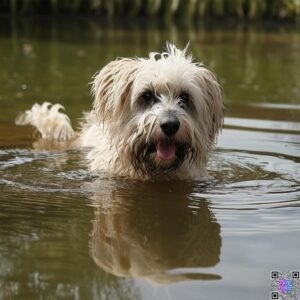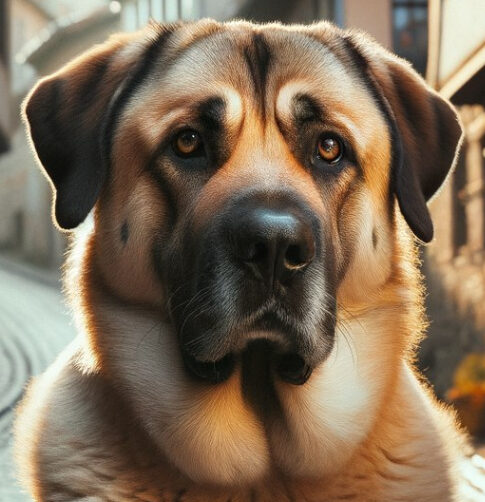🐾 Anatolian Shepherd and Great Pyrenees Mix: The Ultimate Guardian Dog Guide
🐶 1. Introduction
The Anatolian Shepherd and Great Pyrenees mix, often referred to as the Anatolian Pyrenees, is a majestic crossbreed designed for strength, intelligence, and fierce loyalty. This powerful hybrid is not your average family pet—it’s a livestock guardian dog (LGD) by nature.
If you’re looking for a loyal, independent protector that thrives in spacious, structured environments, read on. This hybrid brings together the Turkish Anatolian Shepherd’s assertiveness and the Great Pyrenees’ calm, nurturing demeanor into one incredible dog.

🏞️ 2. Origin of the Parent Breeds
🐕 Anatolian Shepherd History
- Origin: Turkey
- Bred for: Protecting livestock from predators
- Known for: Independence, alertness, territorial behavior
- Age-old lineage: Thought to be thousands of years old.
🐩 Great Pyrenees History
- Origin: France/Spain (Pyrenees Mountains)
- Bred for: Guarding flocks against wolves and bears
- Known for: Gentle giant nature, patience, loyalty
By crossing these two ancient LGDs, you get a hybrid that excels in security, independence, and guardianship.
🐕🦺 3. Appearance and Size
The Anatolian Pyrenees is impressively large and muscular. They often have a regal and imposing stature with features inherited from both parents.
| Trait | Details |
|---|---|
| Weight | 90–140 lbs (males can go higher) |
| Height | 27–32 inches at the shoulder |
| Coat Type | Thick double coat, water-resistant |
| Colors | Cream, tan, brindle, fawn, white, badger mask |
| Eyes | Almond-shaped, often brown or amber |
| Ears | Medium, V-shaped, drop ears |
| Tail | Long and bushy, often curled when alert |
🔎 Note: Coat color and body structure can vary depending on which parent breed is more dominant.
❤️ 4. Temperament and Personality
This hybrid is the epitome of calm strength.
✅ Key Traits:
- 💂 Protective: Natural guardians
- 🤫 Quiet but assertive: Not big barkers unless necessary
- 🧠 Independent thinkers: Sometimes stubborn
- 👨👩👧👦 Loyal to family: Bonds deeply with owners
- 🐕 Reserved with strangers: Needs early socialization
Potential Behavior Issues (if not trained):
- Overprotectiveness
- Territorial aggression
- Escaping fenced areas
🧠 5. Intelligence and Trainability
These dogs are very intelligent but not always obedient. Their intelligence is rooted in problem-solving and decision-making, not just command-following.
Training Tips:
- 🔁 Use consistent, firm leadership.
- 🧀 Use treats and praise—avoid harsh methods.
- 🕒 Keep training sessions short and purposeful.
- 🤝 Early socialization is key (people, pets, environments).
🧩 Challenge: These dogs may ignore commands they deem unnecessary. They are not “eager to please” like Golden Retrievers but will follow a trusted leader.
🏃 6. Exercise Needs
Don’t be fooled by their laid-back look—Anatolian Pyrenees need daily mental and physical stimulation.
| Age Group | Daily Exercise Needs |
|---|---|
| Puppy | 30-45 mins + mental games |
| Adult | 1.5–2 hours (walks, play, tasks) |
| Senior | 30-60 mins (gentle, slow-paced) |
🛑 Avoid:
- Dog parks (territorial issues)
- Apartment living (they need space)
🧼 7. Grooming and Coat Care
These hybrids inherit the dense double coat from both parents.
Weekly Grooming Checklist:
- 🖌️ Brush 2–3x/week (daily in shedding season)
- 🐾 Trim nails monthly
- 👂 Check ears weekly (prevent infection)
- 🦷 Brush teeth 2–3x/week
💨 Shedding Level: HIGH
🧼 Bath Frequency: Every 6–8 weeks or as needed
🩺 8. Health and Lifespan
The hybrid may inherit both strengths and vulnerabilities from its parents.
| Health Concern | Risk Level | Prevention/Notes |
|---|---|---|
| Hip Dysplasia | High | Weight control, joint supplements |
| Bloat (GDV) | Moderate | Feed smaller meals, avoid fast eating |
| Entropion/Ectropion | Moderate | Regular vet checks |
| Obesity | High | Portion control, exercise |
| Osteosarcoma | Low | Regular vet screenings |
🧬 Lifespan: 10–13 years
🍖 9. Feeding and Nutrition
These large, muscular dogs need high-quality food with plenty of protein.
Feeding Chart by Age
| Age | Calories/day | Notes |
|---|---|---|
| Puppy | 1200–1800 | Puppy large breed formula |
| Adult | 2000–2500 | Split into 2 meals, avoid overfeeding |
| Senior | 1600–2000 | Watch for joint & digestive health |
Must-Have Nutrients:
- 🥩 Protein: 25–30%
- 🐟 Omega-3s: For joints and coat
- 💊 Glucosamine & chondroitin: Joint support
🚫 Avoid low-protein, carb-heavy kibble.
🏠 10. Living Environment Needs
Best Living Situations:
- 🏡 Rural homes with land
- 🐑 Farms or ranches
- 🚪 Homes with secure 6-ft+ fencing
Not Ideal For:
- Apartments
- First-time dog owners
- City dwellers with no yard
These dogs love having a job to do—idle boredom can cause behavioral issues.
🎯 11. Training Tips for Beginners
- 🗣️ Start training EARLY (8–12 weeks)
- 🚫 Avoid punishment-based training
- 🦮 Use long-leash recall training in open spaces
- 🧠 Add puzzle toys and obedience drills
- 🤗 Use calm, assertive energy
Tip: Train before meals—hunger boosts motivation.
🤝 12. Socialization and Interaction
Without proper socialization, this mix may become:
- Suspicious
- Overprotective
- Aggressive toward unknown animals
Socialization Plan:
- 🧍 Introduce visitors gradually
- 🐕 Controlled dog-to-dog play dates
- 🚗 Take your pup on car rides and errands
- 🐾 Obedience classes (if available)
🛡️ 13. Guarding Instincts and Working Abilities
The Anatolian Pyrenees is born to guard. Whether it’s a flock, your family, or your property—this dog takes security seriously.
Guardian Traits:
- Silent watcher (won’t bark unnecessarily)
- Territorial but not aggressive
- Nighttime patrolling instincts
Great for:
- Livestock guarding
- Property defense
- Hiking companions in remote areas
👨👩👧 14. Anatolian Pyrenees with Kids and Pets
With Children:
- ✅ Protective, patient, gentle
- 🚸 Always supervise young kids (due to size)
- ❤️ Bonds strongly with family kids
With Other Pets:
- 🐕 Dogs: Needs slow introductions; same-sex dogs may cause conflict
- 🐈 Cats: Okay if raised together
- 🐓 Livestock: Excellent guardians when trained
🐾 15. Adoption vs Buying: What to Know
Adoption Pros:
- 🏷️ Lower cost
- 🐾 Save a dog in need
- 🏡 Often already trained
Buying from a Breeder:
- ✅ Know the lineage
- 📋 Get health clearances
- 💵 Cost: ₹50,000 to ₹1,00,000+ ($700–$1,200+)
🎯 Tip: Look for LGD-experienced breeders or Anatolian Pyrenees rescues.
💸 16. Cost of Ownership
| Expense Category | Estimated Annual Cost |
|---|---|
| Food & Supplements | ₹60,000–₹1,00,000 |
| Vet Bills | ₹15,000–₹30,000 |
| Grooming Tools | ₹5,000–₹10,000 |
| Training & Socializing | ₹10,000–₹25,000 |
| Toys & Enrichment | ₹5,000–₹8,000 |
💰 Estimated Total Yearly Cost: ₹95,000 to ₹1,73,000 ($1,100–$2,100)
⚖️ 17. Pros & Cons of Anatolian Pyrenees
✅ Pros:
- 🛡️ Superb guardian instincts
- 🧠 Intelligent and problem-solving
- ❤️ Loyal and loving
- 🐑 Excellent for farms
❌ Cons:
- 🧱 Not apartment-friendly
- 🧼 Heavy shedders
- ❗ Strong-willed and stubborn
- 🐕 May not get along with other pets

❓ 18. Common FAQs
Q: Is the Anatolian Pyrenees aggressive?
A: No, but they are territorial and may appear aggressive without proper training and socialization.
Q: How much space does this dog need?
A: Ideally 1/2 acre or more of fenced land.
Q: Can they live in hot climates?
A: Yes, with shade and water. Their Anatolian roots are desert-adapted.
Q: Do they bark a lot?
A: No, but they will alert bark when necessary—especially at night.
🧠 19. Final Verdict: Is This Hybrid Right for You?
The Anatolian Shepherd x Great Pyrenees mix is a formidable guardian, loyal family member, and independent worker. But they’re not for everyone.
✔️ Ideal For:
- Rural homes with land
- Experienced dog owners
- Families needing a livestock or property guardian
❌ Not Ideal For:
- First-time dog owners
- Apartment living
- People who travel often
